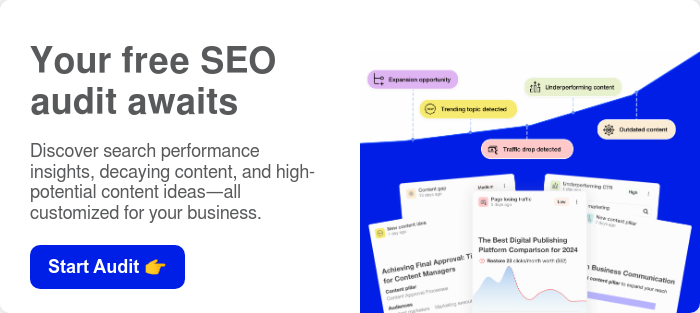Creating content without a clear plan is like embarking on a road trip without a map—you might get somewhere, but it’s unlikely to be your intended destination. SEO content planning ensures your efforts are not only organized but also aligned with the needs of your audience and the goals of your business.
But what exactly is SEO content planning, and why is it such a big deal in digital marketing? How can you create an effective strategy, and which tools can help you streamline the process? In this article, we’ll answer these questions and more, breaking down everything you need to know to make your SEO content work smarter, not harder.
What is SEO Content Planning?
In simple terms, SEO content planning is about creating and organizing content with a focus on ranking well in search engines. It’s the process of researching what your audience is searching for, developing content that meets those needs, and ensuring your efforts align with your broader marketing objectives.
Rather than treating content as a random collection of blog posts, videos, or social media updates, SEO content planning organizes your efforts into a structured approach. This makes sure your content doesn’t just exist but actually drives meaningful results—whether that’s increasing traffic, generating leads, or boosting sales.
At its core, SEO content planning boils down to answering three key questions:
- What does your audience want or need?
- How can you provide it better than anyone else?
- How do you ensure your audience finds it?
Related article: 28 Tools To Make Your Content Planning Perfect in 2025
Why is SEO Content Planning Essential?
If you’ve ever struggled to see results from your content efforts, chances are you didn’t have a clear plan in place. Here’s why SEO content planning is so important for digital marketing teams:
- You maximize reach and visibility: Search engines like Google are often the first stop for potential customers looking for solutions. Proper planning lets your content appear when and where it matters most—on the first page of search results.
- It helps you stay focused: Without a plan, getting lost in the sea of possible topics and formats is easy. SEO content planning ensures every piece of content you create serves a purpose and supports your business objectives.
- You save time and resources: A solid plan prevents duplication of effort, reduces last-minute scrambling for ideas, and ensures your team’s time and energy are spent wisely.
- It builds authority over time: Consistently publishing well-optimized, high-value content helps establish your brand as a trusted voice in your industry, which leads to better rankings and stronger customer relationships.
- It makes results measurable: By setting clear goals and tracking performance, SEO content planning helps you understand what’s working and what’s not so you can adjust your strategy accordingly.
How to Create an Effective SEO Content Plan
1. Start with Your Goals
Before you create anything, define what success looks like for your content strategy. Are you aiming to:
- Increase organic traffic to your website?
- Rank higher for specific keywords?
- Boost engagement with your blog or social media posts?
- Drive conversions, such as sign-ups, downloads, or purchases?
Having clear, measurable goals helps you prioritize your efforts and track progress.
2. Research Your Audience and Keywords
Your audience’s needs and behaviors should shape your content. Start by creating audience personas that include details like demographics, challenges, and search habits.
Next, perform keyword research to uncover what your audience is searching for.
- Use tools like Google Keyword Planner, SEMrush, Ahrefs, or StoryChief to find high-volume and low-competition keywords.
- Focus on long-tail keywords—specific phrases like "best vegan protein powder for athletes" instead of broad terms like "protein powder." Long-tail keywords often attract more qualified leads.
- Identify questions and problems your audience frequently has by exploring forums like Reddit, Quora, or customer reviews in your industry.
Related article: How to Use Audience Insights for Better Content Campaigns
3. Analyze Your Competitors
Competitor research provides invaluable insights into what’s working (and what’s not) in your niche.
- Identify top competitors by searching for your target keywords.
- Evaluate their content: What format are they using? (Blog posts, videos, infographics?) How in-depth is their coverage?
- Look for gaps: Are there questions they’re not answering? Is there room for you to provide a unique perspective or additional value?
By understanding their strengths and weaknesses, you can position your content to outperform theirs.
Related article: How to Write Content That Outranks Competition in SERPs
4. Map Content to Customer Needs
Not all customers are ready to buy. Your content should address different stages of their journey:
- Awareness Stage: Focus on educational content like blog posts, videos, or infographics that introduce your brand and address common pain points.
- Consideration Stage: Offer comparisons, case studies, or how-to guides that showcase the benefits of your solution.
- Decision Stage: Highlight testimonials, FAQs, detailed product descriptions, and pricing information to encourage a purchase.
Example: If you’re marketing skincare products, an awareness piece could be “How to Build a Skincare Routine,” a consideration piece could be “The Benefits of Retinol vs. Vitamin C,” and a decision-stage piece could be “Why Customers Love Our Anti-Aging Serum.”
5. Prioritize Keywords Strategically
Once you’ve collected a list of keywords, prioritize them based on relevance, search volume, and competition. Here’s how:
- Relevance: Focus on keywords that align with your products or services.
- Search Volume: Start with medium- to high-volume keywords for quick wins.
- Competition: Use SEO tools to determine keyword difficulty. Balance your strategy between easier keywords for short-term results and harder ones for long-term goals.
- Keyword Intent: Match content to the intent behind the keyword. For example, "how to bake a cake" calls for a tutorial, while "best stand mixer" signals a buyer's guide.
6. Organize Your Plan in a Content Calendar
A content calendar keeps your team organized and ensures consistency.
- Plan topics at least a month in advance. (Tip: Read how agency iProv managed to plan a year in advance.)
- Include deadlines for each stage of production—research, writing, editing, and publishing.
- Use tools like Trello, Asana, or StoryChief’s editorial calendar to assign tasks and track progress.

Pro Tip: Align your calendar with seasonal trends, upcoming product launches, and industry events for maximum relevance.
Related article: Creating The Perfect AI Content Calendar
7. Create High-Quality, Search-Focused Content
Search engines prioritize content that is valuable, relevant, and user-friendly. To meet these standards:
- Write engaging, original content that addresses your audience’s needs.
- Use keywords naturally in your headlines, subheadings, and body text, but avoid keyword stuffing.
- Structure content for readability with short paragraphs, bullet points, and plenty of subheadings.
- Incorporate visuals like images, videos, and charts to break up text and improve engagement.
- Add internal links to guide readers to related content on your site and external links to credible sources.
8. Maintain Content Quality with Regular Audits
Content isn’t a “set it and forget it” effort. Perform regular audits to ensure your website remains relevant and competitive.
- Use tools like StoryChief to monitor performance metrics like traffic, bounce rate, and keyword rankings.
- Identify outdated content and refresh it with updated data, better keywords, or improved visuals.
- Consolidate underperforming pages or merge them with stronger ones to avoid diluting your site’s authority.
A weekly content audit ensures your SEO content plan stays aligned with your goals and keeps your audience engaged.
Interpreting the Data: How to Measure and Adjust
One of the best things about SEO content planning is that it’s not set in stone. Once your content is out in the world, you’ll have plenty of opportunities to see what’s working and tweak your approach.
Some key metrics to track include:
- Traffic: Are more people visiting your site because of your content?
- Engagement: How much time are they spending on the page? Are they sharing it on social media?
- Conversions: Is your content leading to tangible results, like sign-ups, downloads, or purchases?
- Keyword Rankings: Are you moving up in search results for your target keywords?
By regularly reviewing your data, you’ll be able to identify trends and opportunities to optimize your strategy.
Final Thoughts
SEO content planning is the backbone of successful digital marketing. By understanding your audience, setting clear goals, and using the right tools, you can create a strategy that drives meaningful results.
While tools like StoryChief can streamline the process, the most important thing is to stay consistent and always prioritize quality over quantity. With the right plan in place, your content won’t just attract attention—it will help your business grow.
Take it one step at a time, keep an eye on your data, and adapt as needed. Over time, you’ll see how much of a difference a well-thought-out SEO content plan can make.










